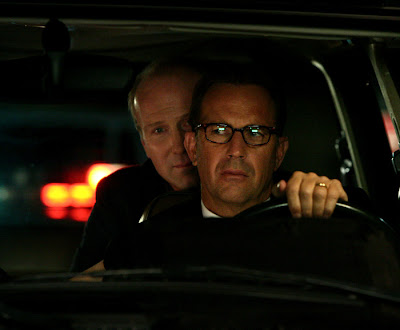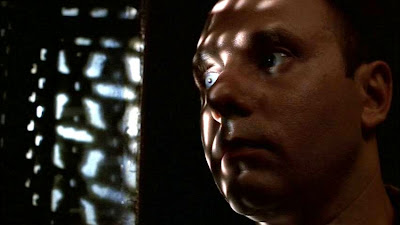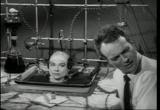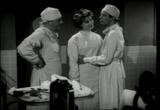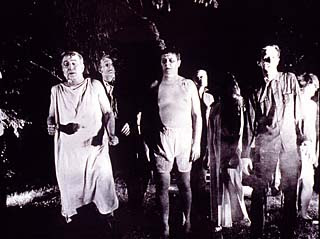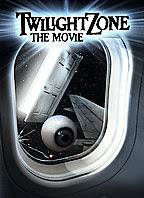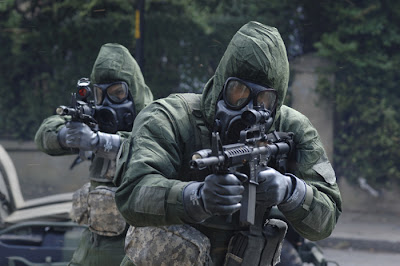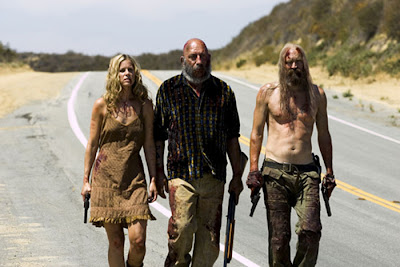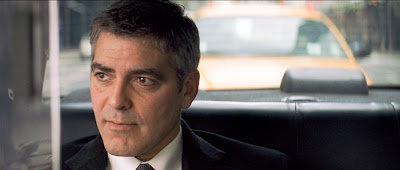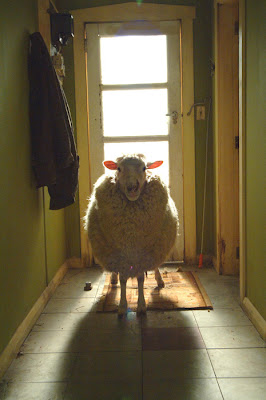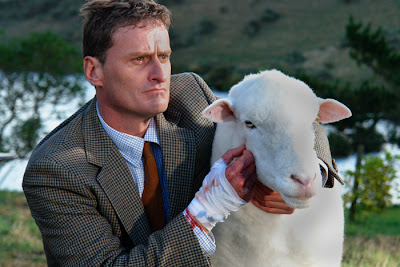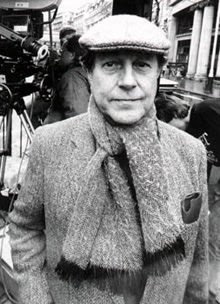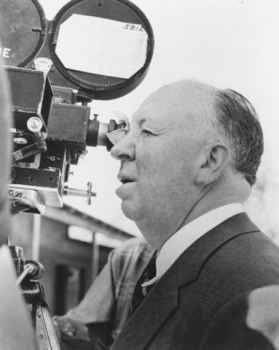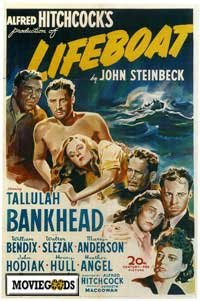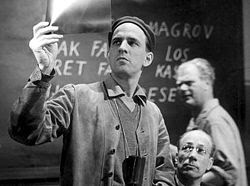
Perhaps no other person has contributed so much to the institution of horror in American entertainment than Stephen King. His reputation for his prolific body of work feeding off the fears of the public is common knowledge, but since he is a writer and not a filmmaker—as can be evidenced from his own attempts to contribute to movie making with efforts like “Maximum Overdrive” and “Sleepwalkers”—many people don’t realize just how many films exist that are based on his works. Probably more than any other writer’s in history. He outsells Agatha Christie and Jesus, and he certainly has had more popular films based on his work.
I have even considered dedicating an entire Horrorfest to the film works of Stephen King, but can’t see limiting myself to one artist like that. But I believe this year’s Horrorfest has encompassed more of King’s work than any other thanks to the inclusion of TNT’s mini-series based on King’s collection of short stories “Nightmares & Dreamscapes”. With that collection of eight hour-long films and two other feature films based on his works screened during this year’s festival, I certainly created a Stephen King sub-festival this year. I only wish Frank Darabont’s adaptation of his short story “The Mist” had been released to theaters three weeks earlier, and I could have included that one this year as well.
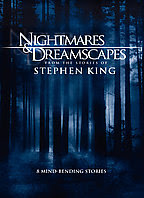 “Nightmares & Dreamscapes”
“Nightmares & Dreamscapes”
Battleground. When I was twelve or so, Dungeons & Dragons ruled my life. Even when we weren’t gaming, my friends and I would get together to paint little figurines of orcs and goblins and skeleton armies. During this time I was inspired to write a short story in which a young gamer’s collection of Dungeon & Dragons figures came to life and attacked him.
Many years later, I was reading Stephen King’s short story “Battleground” in which a hit man is attacked by a box of plastic army soldiers. As I read, I thought to myself, “Gee, I could swear I’ve read this story before.” No, I don’t think King stole my idea. In fact, I believe he had published it long before I wrote mine and even collected it in his first anthology of shorts “Night Shift”. And I’m sure his story is much better than what my juvenile mind could muster. But that same thought echoed through my memory as I watched the filmed version of “Battleground”.
“Battleground” is certainly a unique film experience. Not because of its concept of toys come to life, which has certainly been seen many times before in much lesser films. No, “Battleground” is unique because during its hour-long running time not one word is ever uttered by any of its characters.
William Hurt stars as the hit man in yet another wonderful performance by the actor. This hit man is possibly given more weight in my mind because of Hurt’s spectacular performance as a crimelord in David Cronenberg’s great film “A History of Violence”. Of course, that performance was distinguished by an exquisite speech given by Hurt. This role is distinguished by Hurt’s incredible ability to convey an entire history and ethos without one word of dialogue to help. “Battleground” isn’t nearly as impressive as a plot as it is as an example of the influential combination of taut filmmaking and a seamless performance.
Crouch End. There is a type of horror film that is just plain bizarre. The feature “Don’t Look Now”, which I viewed earlier in this festival, might fit into this category, at least considering its conclusion. “Crouch End” is mostly bizarre. It involves American newlyweds, played by Eion Bailey and Claire Forlani, honeymooning in London. They are invited by a colleague of the husband to visit in a place called Crouch End. No cabbies want to take the couple to Crouch End and when one finally does he warns the couple not to stay because Crouch End is a “thin spot” between dimensions.
That’s when all the weird stuff begins. Most of which is entirely inexplicable. Something happens to the husband that changes him and forces him to cross over while the wife tries to get them back to their own dimension. There are never any fully explained details about this other dimension, and I kind of liked that.
“Crouch End” is certainly horrific, but the events this couple is put through are so strange there is little for the audience to connect to. Bailey does a great job altering the husband’s fairly charming personality into something darker after he begins to yearn to stay in Crouch End, but the otherworldly nature of this other dimension is tough to grasp. Instead of being disturbed by what was happening, I found myself struggling to understand it instead. Sometimes weird is just weird.
Umney’s Last Stand. There is a line in “Umney’s Last Stand” uttered by a writer, who has decided to write his most popular character Umney out of his universe so he can write himself into his place, which really struck a nerve for me. He speaks of how selfish and full of themselves writers are. Are we all so selfish? I dunno. Maybe. We all play God, especially us critics. King’s writer calling me selfish hurt. But I couldn’t flatly deny its truth.
Clyde Umney is a private investigator who inhabits a typical 1930’s fantasy noir world. Sam Landry is the author who has decided to take the place of his most successful creation to avoid real life. He says, “I’ve been going through an interesting period in my life. There is nothing more detrimental to a writer’s output than an ‘interesting period’.” This is certainly true.
William H. Macy plays both characters with his usual mastery of the mannerisms of the not quite comfortable. And director Rob Bowman does a great job contrasting the cute style of Umney’s world versus the quite serious predicament he finds himself in once his creator turns the tables on him. Bowman directed some of the best and quirkiest “X-Files” episodes. He does a good here balancing the humor of Umney’s lack of understanding of his circumstance and surroundings with the dark nature of what Landry has chosen to do not only to his creation, but to his own existence. It is a lesson learned for this writer.
The End of the Whole Mess. Mad scientists have long been a staple of the horror genre. They were more popular in the days of “Frankenstein” and other universal creature features, but they always represented a weakness that comes with genius. Obsession leaves blind spots, and the mad scientist is the most obsessive genius.
Mad scientists never seemed to be up Stephen King’s alley. He always seemed to prefer the more deliberate evil. The kind that keeps you awake at night. “The End of the Whole Mess” is King’s take on the mad scientist. King’s scientist has good intentions, but never stops to ponder the possible consequences of his actions. It is also the tale of two brothers and how family members have trouble abandoning their habitual roles with each other, even when it goes against their better natures.
There are two brothers, one a smart documentary filmmaker, the other a genius who can’t seem to find his place in the world. The brothers are played by two underrated actors, Ron Livingston and Henry Thomas respectively. When the violence of the human race becomes too much for the genius to handle, punctuated by the events of 9/11, he finally finds his calling and devotes his work to developing a cure for human aggression.
But the results of this cure are not the typical “Body Snatcher” event of everyone becoming the same. No, King has always preferred horror based more on real things that scare him personally. In this case that horror is Alzheimer’s. The human race is pacified, but soon it becomes apparent that the cure has made people more susceptible to this harsh degenerative mind disease. Since everyone contracts the disease at a much younger age, it seems no scientist will be able to stay focused long enough to develop an antidote. Let’s hope the human race can be spared such a pathetic fate.
The Road Virus Heads North. I never read King’s “Nightmares & Dreamscapes” anthology, but like “Battleground”, “The Road Virus Heads North” is from another of his collections that I did read. The two also share a much simpler premise than any of the other entries here. A man finds a disturbing painting at a garage sale on his way from Boston to his home in rural Maine. As he gets closer to his destination he realizes the painting is changing, its backgrounds suggesting that it is following him. The picture’s intentions cannot be good.
“Road Virus” is a strange story that doesn’t have a typical plot arc. It doesn’t quite seem fully explored, yet that isn’t a drawback. It again exemplifies King’s attempts to try out ideas that scare him personally. This idea of a picture coming to life is almost a child’s fantasy and because of that doesn’t really seem to deserve a full exploration in an adult context, and that works here. Although King did use the device in one of his full length novels “Rose Madder”, which has yet to be made into a feature film.
The casting of Tom Berenger in the lead role here adds validity to the material and what is produced by director Sergio Mimica-Gazzan is moody and terse. Wisely, too much is never shown in regards to action. This keeps the horror primarily psychological. Seeing the action of what develops would cheapen it and spotlight the fantastical nature.
The Fifth Quarter. Like many of King’s non-horror stories, “The Fifth Quarter” shows just how mature King can be as a storyteller. For the second time in this anthology of films, the direction is handled by “X-Files” veteran Rob Bowman, who makes no attempt to bring in the element of the supernatural that he is most known for as a director.
I would place this story among other prison tales of King’s, such as “Rita Hayworth and the Shawshank Redemption” and “The Green Mile”. “The Fifth Quarter” tells the story of a repeat offender whose wife and child have waited patiently for him to get out of prison and turn over a new leaf. But the very night of his release, he is visited by an old colleague who has been duped in a robbery scam. Will he return to the criminal life to take revenge for his friend? Will he come back with the riches his friend had been promised? Will this last scheme land him in the joint once and for all?
The story does a good job of exploring the realities of the situation in which these people of desperation find themselves, and finds a good foundation of humanity on which to base the criminal’s actions. Jeremy Sisto and Samantha Mathis do the leads a couple of solid performances, making this one of the most pleasurable films of the series.
Autopsy Room Four. “Autopsy Room Four” marks the only story from “Nightmares & Dreamscapes” that I have read. It is one of those adaptations that loses something in its translation from words to images. It follows a man who has been mistaken for dead all the way to the autopsy room. Representing yet another of King’s personal fears, the idea itself is quite intriguing. What if you found yourself on the cutting table in the autopsy room, perfectly conscious of what was happening, and unable to give any sign that you were still alive to stop the doctors from cutting you up?
The success of the premise lies in the storyteller’s ability to place the audience within the head of the victim, something that is much easier to accomplish on the page than it is in the medium of film. I recently argued the differences between John Carpenter’s original “Halloween” and the Rob Zombie remake which each try to place the audience in the killer’s head with different approaches. Zombie’s version tries to explain the psychology behind the killer and what shaped his mentality to lead him to such evil. This was ineffective, since it destroyed the unknown element that makes this killer frightening. Carpenter simply places the camera in the killer’s point of view. An effective method that would prove impractical for a story like “Autopsy Room Four” since it would involve a nearly hour-long shot of the ceiling of the autopsy room.
This film opens with a POV shot from inside a body bag, but then depends upon voice-over work and flashbacks to tell the rest of its story. It is a good attempt to recreate King’s panicked psychology, but too much of the humor comes across as goofy and the terrifying element of being stuck without anyway to communicate is lost with the man’s perfect ability to communicate with the audience. I admire this story quite a bit, but some things are better left on the page.
You Know They Got a Hell of a Band. This is by far the worst film of the bunch. “You Know They Got a Hell of a Band” seems like the doodlings of a writer who is trying to break a block. King is a great fan of classic Rock ‘n’ Roll and has utilized his passion for it in many of his works. Here it seems as if he had a silly idea and one day when he couldn’t think of anything else to write, tried to write some “Twilight Zone” horror homage to the great Rock ‘n’ Rollers who had already moved on from this world.
In this story a couple, who are trying to get away for a romantic weekend, get lost on a backwoods road and stumble on a town inhabited by the dead legends of Rock ’n’ Roll’s heyday. Ricky Nelson, Buddy Holly, Dwayne Allman, Jimi Hendrix, Janice Joplin, Roy Orbison, even the line-up seems pasted together from too broad a palate. Stealing the age old horror tradition of creating a world from which the victims cannot escape, they must endure an eternity of the music they once loved, but has now become their hell.
The only thing goofier than the premise of meeting rock icons that will not let you leave their strange purgatory of an endless jam session, is the idea that filming this could be approached in any serious fashion. The whole thing seems shameless and should have been left on the cutting room floor.
***
 1408. This ghost story is from the same Stephen King collection as “The Road Virus Heads North”. Again it is not one of King’s greater works, but somehow it warranted a feature-length film. “1408” follows a ghost hunter who has made a career out of following something he doesn’t even believe in; that is until he checks into room 1408.
1408. This ghost story is from the same Stephen King collection as “The Road Virus Heads North”. Again it is not one of King’s greater works, but somehow it warranted a feature-length film. “1408” follows a ghost hunter who has made a career out of following something he doesn’t even believe in; that is until he checks into room 1408.
It isn’t a bad story, and it makes for a not bad film. But as I said, nothing special. John Cusack brings a good deal of energy and humor to the writer in the film. What I find most interesting, however, is the fact that this story ended up in a feature length theatrical release while all those stories from “Nightmares & Dreamscapes” fit so wonderfully into an individual hour-long format in an anthology series.
In order to stretch the story of “1408” into a feature length film much had to be added. This tends to be where Stephen King adaptations go wrong. I don’t know why people feel they need to adjust what is essentially just a pure entertainment to make it more entertaining. What is done to “1408” is nothing too severe, but I think it would have fit better into TNT’s “Nightmares & Dreamscapes” format. King himself seems to prefer working in TV because they allow him to keep more of his material in tact despite the more restrictive content constraints.
***
 The Dead Zone. With this early ‘80s novel and film adaptation we venture into classic King. “The Dead Zone” tells the story of a teacher who is involved in a car accident on his way home one evening; and after a five-year coma, wakes to find he has the ability of second sight. But at what cost? Not only is the life he knew gone for ever, but his “gift” takes a toll on him physically. He resents this curse until one day he meets a senator who he sees will one day be President of the United States and will bring about nuclear war. Finally his gift has purpose.
The Dead Zone. With this early ‘80s novel and film adaptation we venture into classic King. “The Dead Zone” tells the story of a teacher who is involved in a car accident on his way home one evening; and after a five-year coma, wakes to find he has the ability of second sight. But at what cost? Not only is the life he knew gone for ever, but his “gift” takes a toll on him physically. He resents this curse until one day he meets a senator who he sees will one day be President of the United States and will bring about nuclear war. Finally his gift has purpose.
Directed by David Cronenberg, auteur of the sexually grotesque macabre, this film capitalized on both King’s and Cronenberg’s early popularity. Cronenberg’s involvement could have wound this film up on my “Master Class” essay, although this is a fairly tame effort for the Canadian director, which did not explore his typical early career themes of sexuality.
But Cronenberg was certainly the right choice, since he kept the focus clearly pinpointed on how this “gift” alienated the hero from society, rather than turning him into some superhero. Like King’s novel, Cronenberg takes his time developing the story and never even introduces the future president until after the halfway point. Like King he, spends a good deal of time on the more minor storyline of a serial killer who has eluded the police department of Castle Rock, Maine for many years. In desperation the sheriff enlists the teacher’s unique abilities in uncovering the identity of the killer. This storyline allows Cronenberg at least a taste of the sexual perversity he had all but trademarked at that point in time, while clarifying the hero’s reluctance to utilize his abilities.
I have even considered dedicating an entire Horrorfest to the film works of Stephen King, but can’t see limiting myself to one artist like that. But I believe this year’s Horrorfest has encompassed more of King’s work than any other thanks to the inclusion of TNT’s mini-series based on King’s collection of short stories “Nightmares & Dreamscapes”. With that collection of eight hour-long films and two other feature films based on his works screened during this year’s festival, I certainly created a Stephen King sub-festival this year. I only wish Frank Darabont’s adaptation of his short story “The Mist” had been released to theaters three weeks earlier, and I could have included that one this year as well.
 “Nightmares & Dreamscapes”
“Nightmares & Dreamscapes”Battleground. When I was twelve or so, Dungeons & Dragons ruled my life. Even when we weren’t gaming, my friends and I would get together to paint little figurines of orcs and goblins and skeleton armies. During this time I was inspired to write a short story in which a young gamer’s collection of Dungeon & Dragons figures came to life and attacked him.
Many years later, I was reading Stephen King’s short story “Battleground” in which a hit man is attacked by a box of plastic army soldiers. As I read, I thought to myself, “Gee, I could swear I’ve read this story before.” No, I don’t think King stole my idea. In fact, I believe he had published it long before I wrote mine and even collected it in his first anthology of shorts “Night Shift”. And I’m sure his story is much better than what my juvenile mind could muster. But that same thought echoed through my memory as I watched the filmed version of “Battleground”.
“Battleground” is certainly a unique film experience. Not because of its concept of toys come to life, which has certainly been seen many times before in much lesser films. No, “Battleground” is unique because during its hour-long running time not one word is ever uttered by any of its characters.
William Hurt stars as the hit man in yet another wonderful performance by the actor. This hit man is possibly given more weight in my mind because of Hurt’s spectacular performance as a crimelord in David Cronenberg’s great film “A History of Violence”. Of course, that performance was distinguished by an exquisite speech given by Hurt. This role is distinguished by Hurt’s incredible ability to convey an entire history and ethos without one word of dialogue to help. “Battleground” isn’t nearly as impressive as a plot as it is as an example of the influential combination of taut filmmaking and a seamless performance.
Crouch End. There is a type of horror film that is just plain bizarre. The feature “Don’t Look Now”, which I viewed earlier in this festival, might fit into this category, at least considering its conclusion. “Crouch End” is mostly bizarre. It involves American newlyweds, played by Eion Bailey and Claire Forlani, honeymooning in London. They are invited by a colleague of the husband to visit in a place called Crouch End. No cabbies want to take the couple to Crouch End and when one finally does he warns the couple not to stay because Crouch End is a “thin spot” between dimensions.
That’s when all the weird stuff begins. Most of which is entirely inexplicable. Something happens to the husband that changes him and forces him to cross over while the wife tries to get them back to their own dimension. There are never any fully explained details about this other dimension, and I kind of liked that.
“Crouch End” is certainly horrific, but the events this couple is put through are so strange there is little for the audience to connect to. Bailey does a great job altering the husband’s fairly charming personality into something darker after he begins to yearn to stay in Crouch End, but the otherworldly nature of this other dimension is tough to grasp. Instead of being disturbed by what was happening, I found myself struggling to understand it instead. Sometimes weird is just weird.
Umney’s Last Stand. There is a line in “Umney’s Last Stand” uttered by a writer, who has decided to write his most popular character Umney out of his universe so he can write himself into his place, which really struck a nerve for me. He speaks of how selfish and full of themselves writers are. Are we all so selfish? I dunno. Maybe. We all play God, especially us critics. King’s writer calling me selfish hurt. But I couldn’t flatly deny its truth.
Clyde Umney is a private investigator who inhabits a typical 1930’s fantasy noir world. Sam Landry is the author who has decided to take the place of his most successful creation to avoid real life. He says, “I’ve been going through an interesting period in my life. There is nothing more detrimental to a writer’s output than an ‘interesting period’.” This is certainly true.
William H. Macy plays both characters with his usual mastery of the mannerisms of the not quite comfortable. And director Rob Bowman does a great job contrasting the cute style of Umney’s world versus the quite serious predicament he finds himself in once his creator turns the tables on him. Bowman directed some of the best and quirkiest “X-Files” episodes. He does a good here balancing the humor of Umney’s lack of understanding of his circumstance and surroundings with the dark nature of what Landry has chosen to do not only to his creation, but to his own existence. It is a lesson learned for this writer.
The End of the Whole Mess. Mad scientists have long been a staple of the horror genre. They were more popular in the days of “Frankenstein” and other universal creature features, but they always represented a weakness that comes with genius. Obsession leaves blind spots, and the mad scientist is the most obsessive genius.
Mad scientists never seemed to be up Stephen King’s alley. He always seemed to prefer the more deliberate evil. The kind that keeps you awake at night. “The End of the Whole Mess” is King’s take on the mad scientist. King’s scientist has good intentions, but never stops to ponder the possible consequences of his actions. It is also the tale of two brothers and how family members have trouble abandoning their habitual roles with each other, even when it goes against their better natures.
There are two brothers, one a smart documentary filmmaker, the other a genius who can’t seem to find his place in the world. The brothers are played by two underrated actors, Ron Livingston and Henry Thomas respectively. When the violence of the human race becomes too much for the genius to handle, punctuated by the events of 9/11, he finally finds his calling and devotes his work to developing a cure for human aggression.
But the results of this cure are not the typical “Body Snatcher” event of everyone becoming the same. No, King has always preferred horror based more on real things that scare him personally. In this case that horror is Alzheimer’s. The human race is pacified, but soon it becomes apparent that the cure has made people more susceptible to this harsh degenerative mind disease. Since everyone contracts the disease at a much younger age, it seems no scientist will be able to stay focused long enough to develop an antidote. Let’s hope the human race can be spared such a pathetic fate.
The Road Virus Heads North. I never read King’s “Nightmares & Dreamscapes” anthology, but like “Battleground”, “The Road Virus Heads North” is from another of his collections that I did read. The two also share a much simpler premise than any of the other entries here. A man finds a disturbing painting at a garage sale on his way from Boston to his home in rural Maine. As he gets closer to his destination he realizes the painting is changing, its backgrounds suggesting that it is following him. The picture’s intentions cannot be good.
“Road Virus” is a strange story that doesn’t have a typical plot arc. It doesn’t quite seem fully explored, yet that isn’t a drawback. It again exemplifies King’s attempts to try out ideas that scare him personally. This idea of a picture coming to life is almost a child’s fantasy and because of that doesn’t really seem to deserve a full exploration in an adult context, and that works here. Although King did use the device in one of his full length novels “Rose Madder”, which has yet to be made into a feature film.
The casting of Tom Berenger in the lead role here adds validity to the material and what is produced by director Sergio Mimica-Gazzan is moody and terse. Wisely, too much is never shown in regards to action. This keeps the horror primarily psychological. Seeing the action of what develops would cheapen it and spotlight the fantastical nature.
The Fifth Quarter. Like many of King’s non-horror stories, “The Fifth Quarter” shows just how mature King can be as a storyteller. For the second time in this anthology of films, the direction is handled by “X-Files” veteran Rob Bowman, who makes no attempt to bring in the element of the supernatural that he is most known for as a director.
I would place this story among other prison tales of King’s, such as “Rita Hayworth and the Shawshank Redemption” and “The Green Mile”. “The Fifth Quarter” tells the story of a repeat offender whose wife and child have waited patiently for him to get out of prison and turn over a new leaf. But the very night of his release, he is visited by an old colleague who has been duped in a robbery scam. Will he return to the criminal life to take revenge for his friend? Will he come back with the riches his friend had been promised? Will this last scheme land him in the joint once and for all?
The story does a good job of exploring the realities of the situation in which these people of desperation find themselves, and finds a good foundation of humanity on which to base the criminal’s actions. Jeremy Sisto and Samantha Mathis do the leads a couple of solid performances, making this one of the most pleasurable films of the series.
Autopsy Room Four. “Autopsy Room Four” marks the only story from “Nightmares & Dreamscapes” that I have read. It is one of those adaptations that loses something in its translation from words to images. It follows a man who has been mistaken for dead all the way to the autopsy room. Representing yet another of King’s personal fears, the idea itself is quite intriguing. What if you found yourself on the cutting table in the autopsy room, perfectly conscious of what was happening, and unable to give any sign that you were still alive to stop the doctors from cutting you up?
The success of the premise lies in the storyteller’s ability to place the audience within the head of the victim, something that is much easier to accomplish on the page than it is in the medium of film. I recently argued the differences between John Carpenter’s original “Halloween” and the Rob Zombie remake which each try to place the audience in the killer’s head with different approaches. Zombie’s version tries to explain the psychology behind the killer and what shaped his mentality to lead him to such evil. This was ineffective, since it destroyed the unknown element that makes this killer frightening. Carpenter simply places the camera in the killer’s point of view. An effective method that would prove impractical for a story like “Autopsy Room Four” since it would involve a nearly hour-long shot of the ceiling of the autopsy room.
This film opens with a POV shot from inside a body bag, but then depends upon voice-over work and flashbacks to tell the rest of its story. It is a good attempt to recreate King’s panicked psychology, but too much of the humor comes across as goofy and the terrifying element of being stuck without anyway to communicate is lost with the man’s perfect ability to communicate with the audience. I admire this story quite a bit, but some things are better left on the page.
You Know They Got a Hell of a Band. This is by far the worst film of the bunch. “You Know They Got a Hell of a Band” seems like the doodlings of a writer who is trying to break a block. King is a great fan of classic Rock ‘n’ Roll and has utilized his passion for it in many of his works. Here it seems as if he had a silly idea and one day when he couldn’t think of anything else to write, tried to write some “Twilight Zone” horror homage to the great Rock ‘n’ Rollers who had already moved on from this world.
In this story a couple, who are trying to get away for a romantic weekend, get lost on a backwoods road and stumble on a town inhabited by the dead legends of Rock ’n’ Roll’s heyday. Ricky Nelson, Buddy Holly, Dwayne Allman, Jimi Hendrix, Janice Joplin, Roy Orbison, even the line-up seems pasted together from too broad a palate. Stealing the age old horror tradition of creating a world from which the victims cannot escape, they must endure an eternity of the music they once loved, but has now become their hell.
The only thing goofier than the premise of meeting rock icons that will not let you leave their strange purgatory of an endless jam session, is the idea that filming this could be approached in any serious fashion. The whole thing seems shameless and should have been left on the cutting room floor.
***
 1408. This ghost story is from the same Stephen King collection as “The Road Virus Heads North”. Again it is not one of King’s greater works, but somehow it warranted a feature-length film. “1408” follows a ghost hunter who has made a career out of following something he doesn’t even believe in; that is until he checks into room 1408.
1408. This ghost story is from the same Stephen King collection as “The Road Virus Heads North”. Again it is not one of King’s greater works, but somehow it warranted a feature-length film. “1408” follows a ghost hunter who has made a career out of following something he doesn’t even believe in; that is until he checks into room 1408.It isn’t a bad story, and it makes for a not bad film. But as I said, nothing special. John Cusack brings a good deal of energy and humor to the writer in the film. What I find most interesting, however, is the fact that this story ended up in a feature length theatrical release while all those stories from “Nightmares & Dreamscapes” fit so wonderfully into an individual hour-long format in an anthology series.
In order to stretch the story of “1408” into a feature length film much had to be added. This tends to be where Stephen King adaptations go wrong. I don’t know why people feel they need to adjust what is essentially just a pure entertainment to make it more entertaining. What is done to “1408” is nothing too severe, but I think it would have fit better into TNT’s “Nightmares & Dreamscapes” format. King himself seems to prefer working in TV because they allow him to keep more of his material in tact despite the more restrictive content constraints.
***
 The Dead Zone. With this early ‘80s novel and film adaptation we venture into classic King. “The Dead Zone” tells the story of a teacher who is involved in a car accident on his way home one evening; and after a five-year coma, wakes to find he has the ability of second sight. But at what cost? Not only is the life he knew gone for ever, but his “gift” takes a toll on him physically. He resents this curse until one day he meets a senator who he sees will one day be President of the United States and will bring about nuclear war. Finally his gift has purpose.
The Dead Zone. With this early ‘80s novel and film adaptation we venture into classic King. “The Dead Zone” tells the story of a teacher who is involved in a car accident on his way home one evening; and after a five-year coma, wakes to find he has the ability of second sight. But at what cost? Not only is the life he knew gone for ever, but his “gift” takes a toll on him physically. He resents this curse until one day he meets a senator who he sees will one day be President of the United States and will bring about nuclear war. Finally his gift has purpose.Directed by David Cronenberg, auteur of the sexually grotesque macabre, this film capitalized on both King’s and Cronenberg’s early popularity. Cronenberg’s involvement could have wound this film up on my “Master Class” essay, although this is a fairly tame effort for the Canadian director, which did not explore his typical early career themes of sexuality.
But Cronenberg was certainly the right choice, since he kept the focus clearly pinpointed on how this “gift” alienated the hero from society, rather than turning him into some superhero. Like King’s novel, Cronenberg takes his time developing the story and never even introduces the future president until after the halfway point. Like King he, spends a good deal of time on the more minor storyline of a serial killer who has eluded the police department of Castle Rock, Maine for many years. In desperation the sheriff enlists the teacher’s unique abilities in uncovering the identity of the killer. This storyline allows Cronenberg at least a taste of the sexual perversity he had all but trademarked at that point in time, while clarifying the hero’s reluctance to utilize his abilities.


